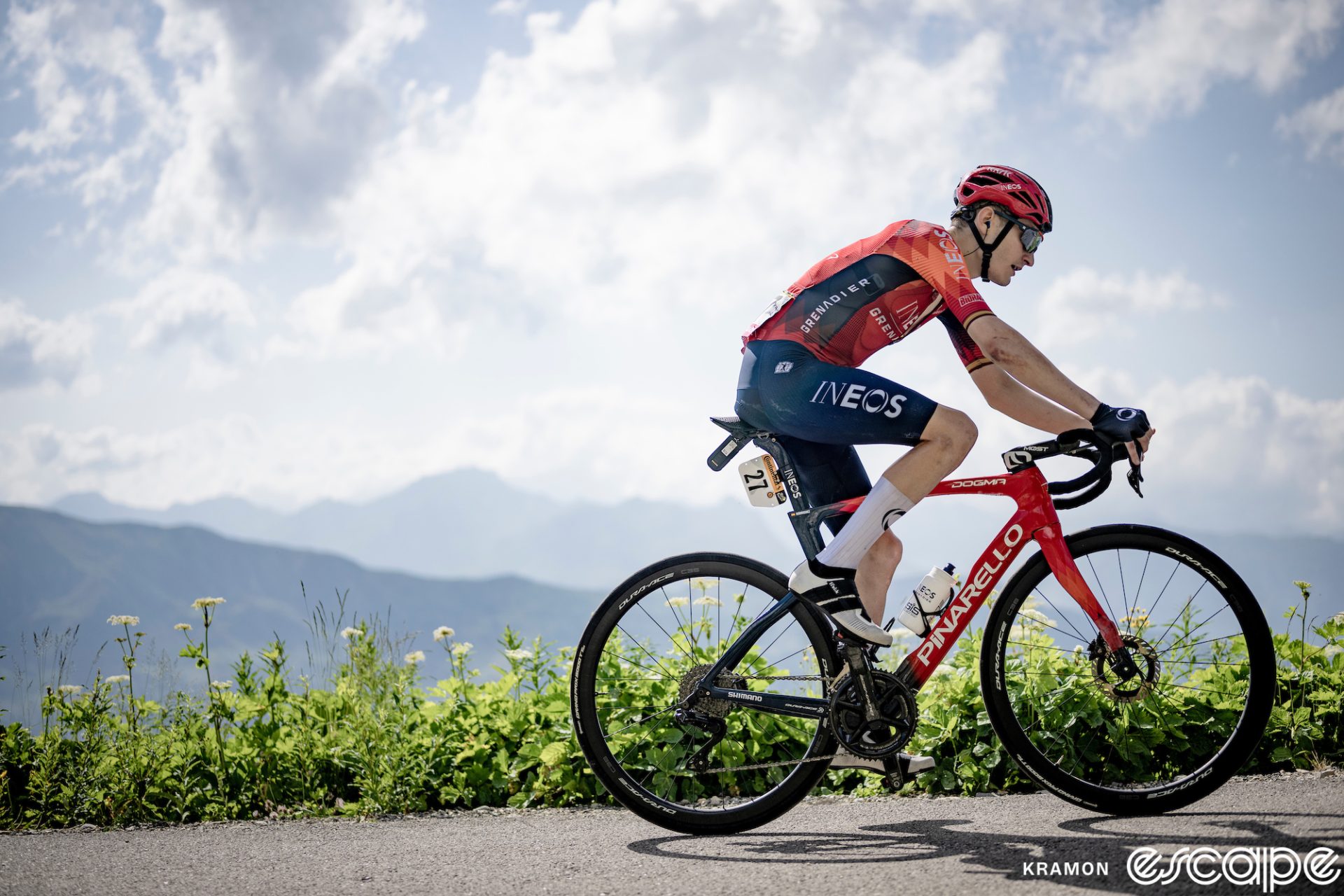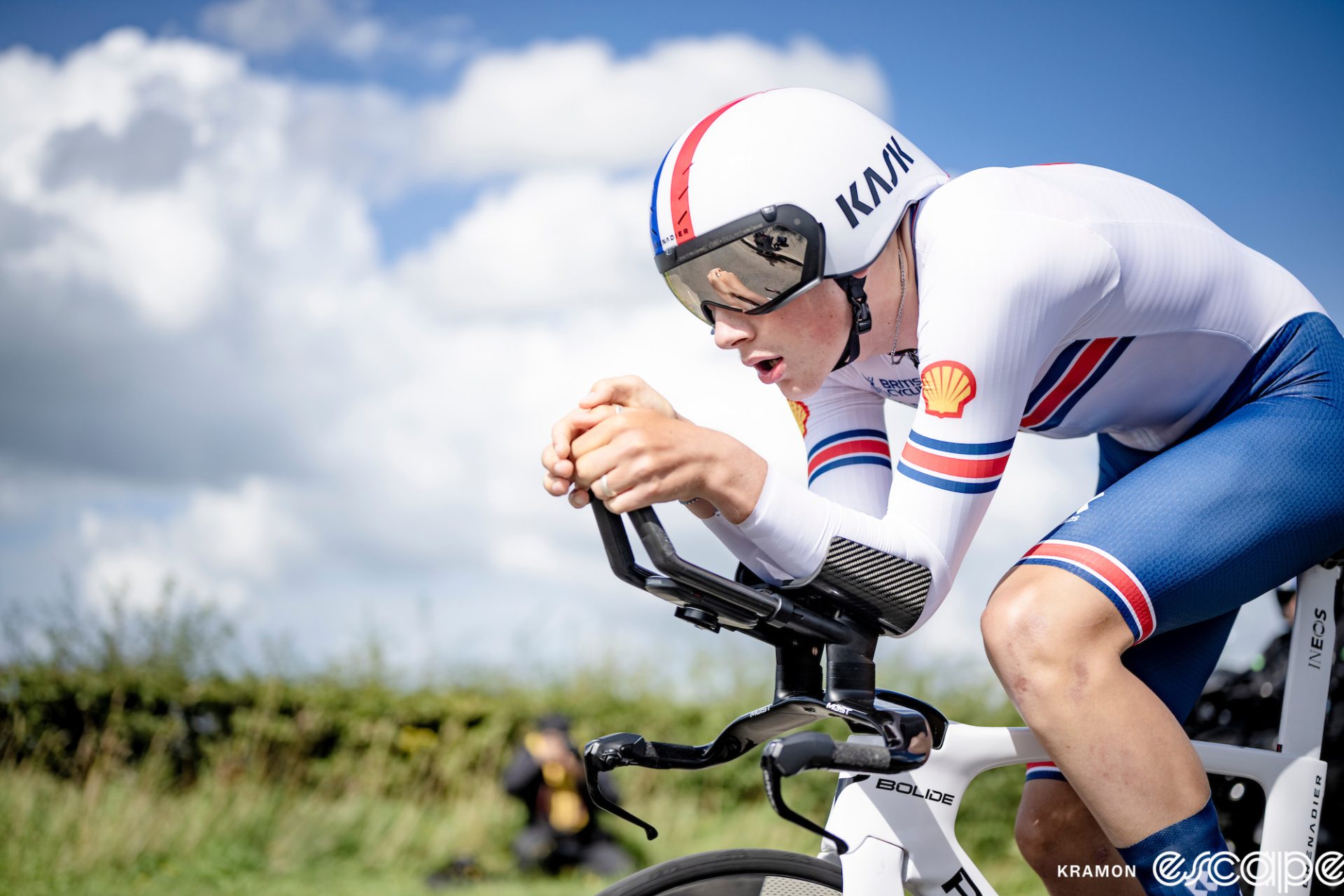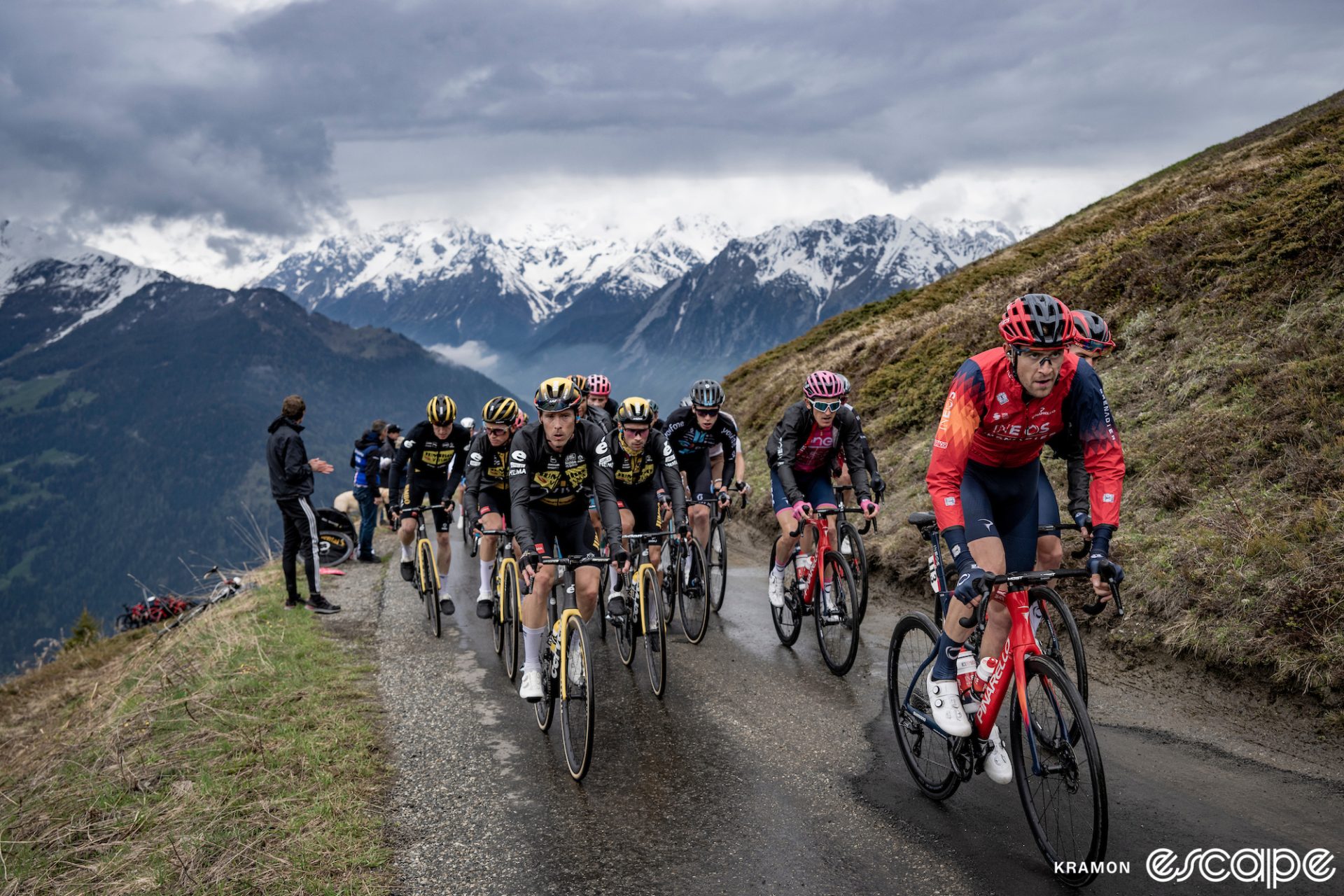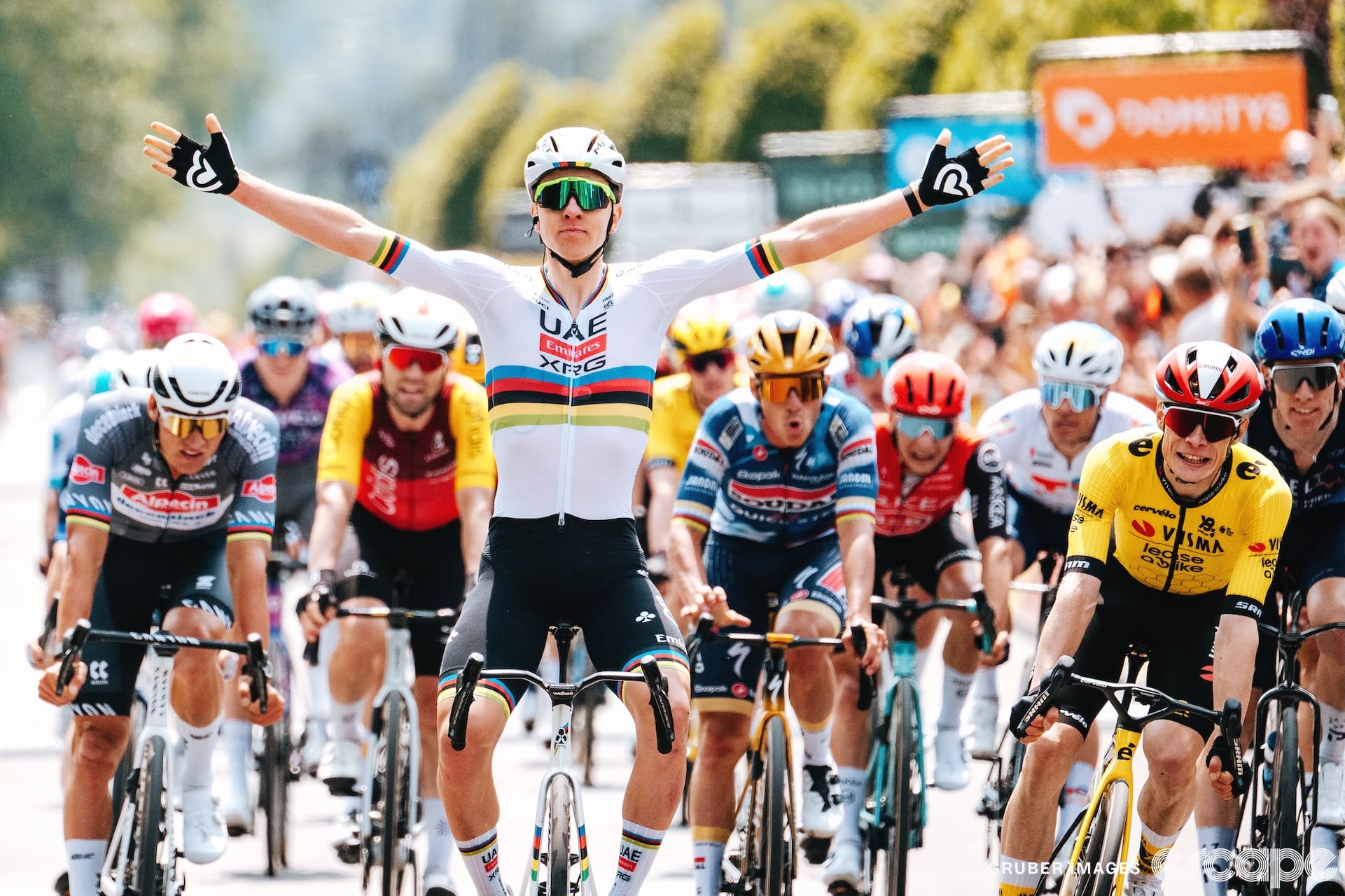With only a few days left in October, the Ineos Grenadiers have finally announced enough official signings for 2024 to have a roster approaching WorldTour numbers. As it turns out, while we were all wondering what the heck was going on at the British team, they were just taking their sweet time working on deals to … keep most of the same roster in place for next year.
Two weeks ago, the number of Ineos Grenadiers officially on board for 2024 was still in the teens, a weird look for a team that has so stably been among the sport's best for a decade. The major intrigue and uncertainty was over whether the squad would bring on a big new name like Primož Roglič or Remco Evenepoel amid all of the Jumbo-Visma/Soudal Quick-Step merger talk mania, but that didn't happen.
Instead, over the last week, the team announced renewals for GC leaders Geraint Thomas (two years) and Carlos Rodríguez (four years) as well as Laurens De Plus (three years) and Ben Swift (two years). Oscar Rodríguez and neopro AJ August – the latter also announced only last week – are the only confirmed newcomers from the past few days, bringing the total number of official signings to 22. That's still three riders short of a minimum WorldTour roster, but it's enough for now to quell questions about what in the world was Ineos' plan for 2024.
A long wait to stay put
In the end, that plan appears to be staying the course with Thomas and Rodríguez in the stage races, while looking to the likes of Tom Pidcock, Filippo Ganna, and Josh Tarling to continue to thrive on their preferred terrain. So why did it take so long for the roster to take shape?

Confirmed facts are sparse, but the prevailing theory is that the team was truly hoping to make some big changes over the past month to replace outgoing riders like Tao Geoghegan Hart and Daniel Martínez. And sure, maybe the team does have some big deals still to come, but the chance of that narrows daily, and it does at least seem like Evenepoel and Roglič (and who knows who else) were seen as real options for this team until very recently.
So rather than overhauling the roster, Ineos looks set to take a similar approach to 2024 to the one they took this season. Given that the once-mighty Grand Tour powerhouse has not won a three-week race since the 2021 Giro d'Italia, and faces a massive challenge to do so next year, that may seem like a bit of a surprise. Then again, what other option do they have?
If Ineos's transition from GC superteam to whatever they are now has seemed sudden, it may be because it's a lot simpler for Grand Tour-winning plans to fall apart than it is for them to come together. With the two best GT riders of the moment locked into long-term deals on other teams, a third just off the market, and a potential fourth now out of reach after the merger failure, there aren't a lot of other options.
Some of Ineos' current position is just rotten luck. When Jumbo-Visma and UAE Team Emirates were signing young talents like Jonas Vingegaard and Tadej Pogačar, Ineos was betting its future on Egan Bernal. That looked like a smart play with his 2019 Tour de France win, and still seemed savvy after he rebounded from back issues in 2020 to win the 2021 Giro d'Italia. But with the long, complicated recovery from his life-threatening crash in January 2022, Bernal's prospects of long-term brilliance dimmed, and Ineos was left scrambling for a replacement. But the thing about Tour winners is you can't just pop down to the shops and pick one up, even with a huge chunk of change burning a hole in your pocket.
At the moment, few people on Earth seem capable of matching Vingegaard, Roglič, and Pogačar, and no amount of Sky-train firepower is going to change that. It's worth remembering that, as much as the team's tactics impacted the racing in 2010s, it was only with a dominant power like Chris Froome at the helm that the team could win Grand Tours so consistently.
With Pogačar and Vingegaard locked in on their respective squads, that left only two other major GC threats as possible options for a team like Ineos, but Evenepoel's Soudal team isn't actually getting gobbled up after all, so it was really only Roglič of the big Grand Tour stars out there that could have been swayed to come aboard. We'll probably never know what kind of negotiations were or weren't going on between Roglič and Ineos, but perhaps Ineos can take comfort knowing that the 34-year-old Slovenian was only going to be a temporary solution.
Betting on youth
Long-term, this team needs to find the next Grand Tour star, and that's going to take time. Maybe Carlos Rodríguez can be that rider. After all, he finished fifth at the 2023 Tour de France at just 22 years old. He would be getting a lot more hype as the next big thing if Bernal and then Pogačar (and Evenepoel to some extent) hadn't reconfigured our expectations the past few seasons of what young riders can achieve.
Maybe Pidcock can continue to develop as a GC rider too; it's something that he and his team seem committed to long-term, and he too is still just 24. There is still time for him to get better in all of the ways required to be a true stage racing contender, but he'll need to focus his attention enough on that to actually make it happen, and that likely won't start in 2024 for the defending Olympic mountain bike champion.

If there is a trend to Ineos' signings, it's youth: 10 of its 22 announced riders are 24 or younger, including a number of intriguing prospects: GC aspirant Thymen Arensman, TT phenomenon Tarling, and classics riders Magnus Sheffield and Ben Turner are other very talented youngsters on the roster who will continue to develop. They'll have the benefit of veterans like Michał Kwiatkowski, Ganna, and Thomas to learn from. In the meantime, Thomas will be a popular standard bearer at whatever races he decides to target. He did very, very nearly win the Giro in 2023 after all. What's more, the core of this team, bar Arensman and Sheffield, is locked up long term: Bernal, Ganna, Pidcock, Turner, and Rodriguez are all signed through at least 2026.
On top of all of that is the fact that Ineos is still actually a pretty good team by most standards, if not by their own Grand Tour-focused ones. They're fourth in the season-ending UCI teams rankings, and by PCS points, which seem about as good a measure as any other arbitrary ranking system, the Ineos Grenadiers were the third-ranked team in the men's peloton this season.
They may not have had the GC success to which we've all become accustomed, but the team did win 36 races this season, including two Tour de France stages and Strade Bianche, not to mention that near-miss at the Giro even after losing Geoghegan Hart to injury. The results this squad achieved in 2023 would not lead to any cries that "the sky is falling" at almost any other team.
That said, it's also reasonable to expect more from a team with such a massive budget, and if the team's ownership feels that way, the pressure could be mounting to perform.
Other signings are certain to be announced in the next few days but, at this point, we know the riders that will make up the core of the Ineos Grenadiers in 2024. The question is what might change to help that group deliver on the Grand Tour expectations they just missed out on this year.
Did we do a good job with this story?




